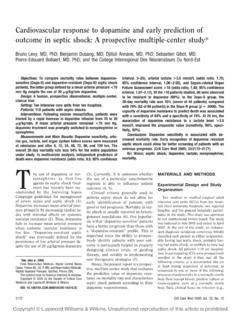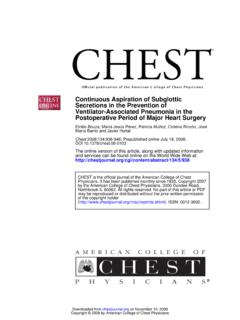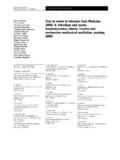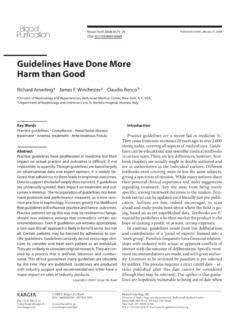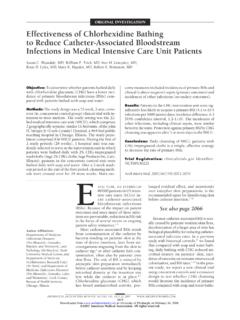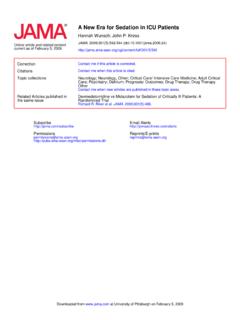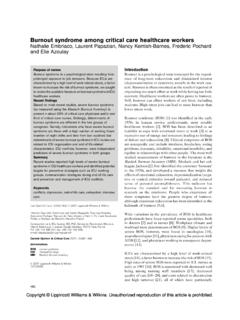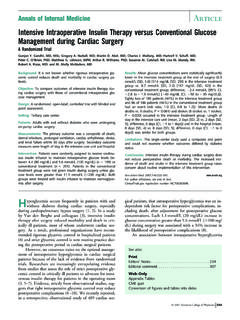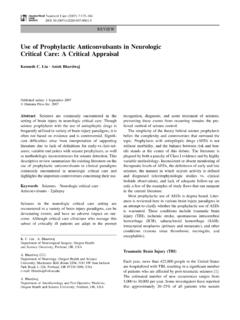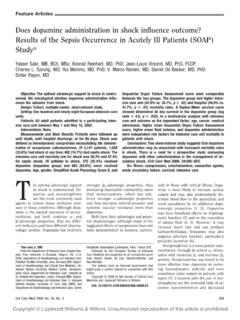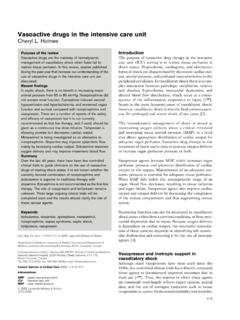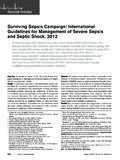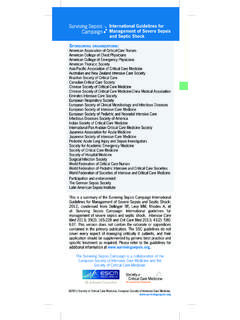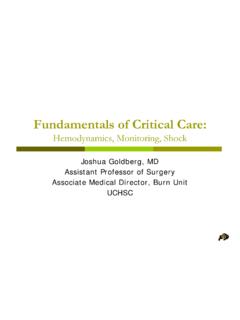Transcription of Feature Articles - ccmpitt.com
1 Feature Articles duration of hypotension before initiation of effective antimicrobial therapy is the critical determinant of survival in human septic shock*. Anand Kumar, MD; Daniel Roberts, MD; Kenneth E. Wood, DO; Bruce Light, MD; Joseph E. Parrillo, MD;. Satendra Sharma, MD; Robert Suppes, BSc; Daniel Feinstein, MD; Sergio Zanotti, MD; Leo Taiberg, MD;. David Gurka, MD; Aseem Kumar, PhD; Mary Cheang, MSc Objective: To determine the prevalence and impact on mortal- tension was associated with a survival rate of Each hour ity of delays in initiation of effective antimicrobial therapy from of delay in antimicrobial administration over the ensuing 6 hrs initial onset of recurrent/persistent hypotension of septic shock. was associated with an average decrease in survival of By Design: A retrospective cohort study performed between July the second hour after onset of persistent/recurrent hypotension , 1989 and June 2004. in-hospital mortality rate was significantly increased relative to Setting: Fourteen intensive care units (four medical, four sur- receiving therapy within the first hour (odds ratio ; 95%.))
2 Gical, six mixed medical/surgical) and ten hospitals (four aca- confidence interval, ). In multivariate analysis (including demic, six community) in Canada and the United States. Acute Physiology and Chronic Health Evaluation II score and Patients: Medical records of 2,731 adult patients with septic therapeutic variables), time to initiation of effective antimicrobial shock. therapy was the single strongest predictor of outcome. Median Interventions: None. time to effective antimicrobial therapy was 6 hrs (25 75th per- Measurements and Main Results: The main outcome measure centile, hrs). was survival to hospital discharge. Among the 2,154 septic shock Conclusions: Effective antimicrobial administration within the patients ( total) who received effective antimicrobial ther- first hour of documented hypotension was associated with in- apy only after the onset of recurrent or persistent hypotension , a creased survival to hospital discharge in adult patients with strong relationship between the delay in effective antimicrobial septic shock.
3 Despite a progressive increase in mortality rate with initiation and in-hospital mortality was noted (adjusted odds ratio increasing delays, only 50% of septic shock patients received [per hour delay], 95% confidence interval , p < effective antimicrobial therapy within 6 hrs of documented hypo- .0001). Administration of an antimicrobial effective for isolated or tension. (Crit Care Med 2006; 34:1589 1596). suspected pathogens within the first hour of documented hypo- KEY WORDS: sepsis; antimicrobial; timing; delay; outcome D espite the fact that current for infections causing critical illness of- studies have been done, the delay has international guidelines sug- ten awaits thorough clinical evaluation, most often been timed to admission to gest initiation of antimicro- resuscitative measures, initial stabiliza- the intensive care unit (ICU) or the emer- bial therapy within an hour tion, and investigative efforts (2 6). gency room. No studies have examined of presentation with severe sepsis and Relatively few studies have rigorously treatment delays in relation to defined septic shock, no clinical studies exist to examined the effect of delays of antimi- physiologic variables such as hypoten- support this recommendation (1).
4 In re- crobial therapy in critically ill, infected sion. We have recently demonstrated that ality, initiation of antimicrobial therapy patients (7 17). To the extent that these the onset of hypotension is a critical *See also p. 1819. Consulting Unit, Department of Community Health Sci- Light is a consultant for Eli-Lilly and Co. Dr. Parrillo has From the Section of Critical Care Medicine, Health ences, University of Manitoba, Winnipeg, MB (MC). received research grants from GlaxoSmithKline for Sciences Centre/St. Boniface Hospital, University of Supported, in part, by unrestricted grants from porcine/human research on sepsis; he also holds Manitoba, Winnipeg, MB, Canada (AK, DR, BL, SS, RS); Eli-Lilly, Pfizer, Merck, and Astra-Zeneca. Additional grants from Arginox, DeepBreeze, and Minimitter. Dr. Section of Pulmonary and Critical Care Medicine, Uni- support was provided by the Health Sciences Centre Parrillo is also on Advisory Boards for Edwards, Glaxo- versity of Wisconsin Hospital and Clinics, Madison, WI Department of Research and Health Sciences Centre SmithKline, and OrthoBioTech (Johnson & Johnson).
5 (KEW); Cooper Hospital/University Medical Center, Foundation. Companies that provided partial grant The remaining authors do not have any conflicts of Robert Wood Johnson Medical School, UMDNJ, Cam- support for this project had no role in study design; interest to disclose. den, NJ (JEP, SZ); St. Agnes Medical Center, Baltimore, collection, analysis, or interpretation of data; writing of Address requests for reprints to: Anand Kumar, MD (DF); Section of Pulmonary and Critical Care Med- the report; or the decision to submit the work for MD, E-mail: icine, Rush-Presbyterian-St. Luke's Medical Center, publication. Copyright 2006 by the Society of Critical Care Chicago, IL (LT, DG); Laurentian University, Biomolec- Dr. Kumar has received honoraria for lectures from Medicine and Lippincott Williams & Wilkins ular Sciences Program and Department of Chemistry Eli-Lilly and Co. and Merck and Co. He has also and Biochemistry, Sudbury, ON (AK); and Biostatistical received grant support for this project as noted.
6 Dr. DOI: Crit Care Med 2006 Vol. 34, No. 6 1589. marker of increased mortality in a mu- dix. To qualify as potential pathogens causing was uniformly considered to be incapable of rine model of Escherichia coli peritonitis/ shock, isolates from both local site and/or causing septic shock. Other coagulase- septic shock (18). Based on these find- blood cultures were required to have been negative staphylococci were similarly consid- ings, a retrospective multiple-center obtained within 48 hrs of onset of shock. The ered to be unlikely to cause septic shock un- time of initiation of effective antimicrobial less present as a sole isolate in multiple blood study was undertaken to examine the re- therapy ( , with in vitro activity appropriate cultures in the absence of evidence of endo- lationship between the delay in initiation to isolated pathogenic organisms or, if a vascular infection. of effective antimicrobial therapy from pathogenic organism was not isolated, appro- For culture-negative septic shock, effective initial onset of recurrent or persistent priate for the underlying clinical syndrome) therapy was deemed to be initiated when anti- hypotension and survival in septic shock.
7 Following onset of recurrent or persistent hy- microbials consistent with broadly accepted potension was determined for all cases. Iden- guidelines for empirical management of the typ- tification of recurrent/persistent hypotension ical pathogens for the clinical syndrome (in the METHODS as described subsequently was inclusive of am- context of host immune/health status, environ- bulance, paramedic, or nursing home records. mental factors, and local flora) were given. For A retrospective review of three patient co- Questionable cases or data elements were re- the purposes of this study, effective (empirical). horts of adult ( 18 yrs of age) septic shock viewed by the principal investigator for adju- therapy of culture negative infections leading to was performed. The study was approved dication. septic shock was defined by the recommenda- through the Health Ethics Board of the Uni- A series of predetermined rules were cre- tions enumerated in Table 1 Clinical approach versity of Manitoba and at each individual par- ated to assess effectiveness and timing of an- to initial choice of antimicrobial therapy in the ticipating center.
8 A waiver of the requirement timicrobial therapy ( , how to determine at Sanford Guide to Antimicrobial Therapy (34th for informed consent was obtained under the what point shock has occurred; how to deter- Ed.) (23). regulations of each participating site. mine which antimicrobial should be consid- For unanticipated scenarios not covered by In the first cohort, all septic shock cases ered critical for implementation of effective the predetermined rules, data were reviewed admitted to the adult ICUs (two medical, two antimicrobial therapy in a mixed infection). independently by two infectious disease/. general surgical, five mixed) of all hospitals (two Notable examples of these rules included that critical care medicine physicians blinded to tertiary, five community) in the province of the numerically dominant fungal or Gram- outcome. Agreement allowed data entry. Dis- Manitoba, Canada, from May 1999 to June 2004 negative isolate was generally considered to cordant assessments were reviewed by a third were identified using a locally developed ICU have the primary role for mixed flora intraab- similarly trained physician whose decision was database in which ICU admission and acquired dominal infections.
9 With semiquantitatively determinative. A similar adjudication ap- similar organism densities, the most resistant proach was used for other issues where clini- diagnoses are prospectively encoded by the at- Gram-negative (or fungal organism if present) cal judgment was required. tending physician and confirmed by specially was considered to be the primary pathogen. Definitions. hypotension was defined as a trained research nurses (19). Similar rules held for multiple lung isolates mean blood pressure of 65 mm Hg, a systolic In a second, comprehensive cohort, all although in that case, enterococci were con- blood pressure of 90 mm Hg, or a decrease cases of septic shock occurring between June sidered to be the primary etiological organism in systolic pressure of 40 mm Hg from the 1989 and April 1999 at a single adult academic only in the absence of other, more plausible patient's baseline consistent with Society of tertiary care institution (one medical and one pathogens. In addition, Candida species iso- Critical Care Medicine/American College of general surgical) in Winnipeg, Manitoba, were lated from lung were considered to be colo- Chest Physicians criteria for septic shock (20).
10 Similarly identified using the same database. nizers (unless also present at multiple other An episode of hypotension was considered to In the final cohort, consecutive adult sep- sites and/or the patient was immunosup- represent the initial onset of septic shock tic shock patients (approximately 150 each pressed, in which case disseminated infection when a) hypotension persisted from onset de- from July 1999 to June 2004) at three aca- was diagnosed). Staphylococcus epidermidis spite fluid ( 2 L of saline or equivalent) ad- demic American institutions were identified using a combination of internal ICU registries and/or International Classification of Diseases Table 1. Chronic comorbidities of patients with septic shock Revision 9 coding strategies depending on the %. specific institutions coding practices. Following initial identification, each po- Acquired immune deficiency syndrome (1993 CDC criteria) tential case was screened to determine Acute or chronic lymphoma whether the case met specific criteria for sep- Acute or chronic leukemia/multiple myeloma tic shock as described by the 1991 Society of Metastatic solid cancer Critical Care Medicine/American College of Immunosuppressive chemotherapy or long-term steroid Chest Physicians Consensus Statement on therapy ( 10 mg prednisone equivalent daily).
